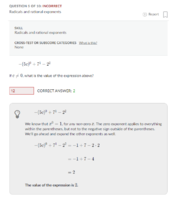Benstephens1164
New member
- Joined
- Dec 20, 2020
- Messages
- 2
As I was reviewing my khan academy SAT math questions, I came across this one. I now know that the first two terms equal -1 and 7, and I understand how to get those numbers but I am confused about the -2^2. I tried searching google about this and some sites said that -2^2 could be 4 and other sites said it is -4. I always thought that a negative squared was essentially just a negative times a negative, thus making it a positive answer. Apparently, this is not the case but I was just wondering why it doesn't work like that in this question when all other times in school I have done a negative squared, the outcome was positive. Any help would be greatly appreciated as I have not been able to find out why it is a negative 4.


